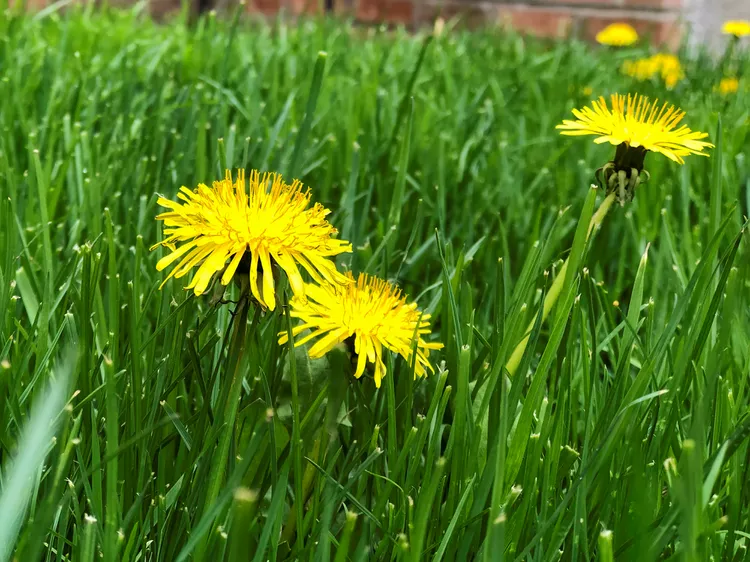When opportunity knocks, dandelions answer. That’s one reason they’re such a common sight in landscapes far and wide. When you discover dandelions infiltrating your lawn, listen closely to what they are telling you to discourage the opportunistic weed and take action.
Quincy Law is an assistant professor of horticulture at Iowa State University.
“Dandelions are opportunistic invaders. If they are popping up in your lawn, it means that the dandelions have found an opportunity to grow,” says Quincy Law, assistant professor of horticulture at Iowa State University. “These opportunities include bare spots and conditions more favorable for dandelion growth than for turfgrass.”
Law should know. He teaches classes on turfgrass establishment and management and has researched methods of improving the turfgrass ecosystem to ensure optimum health and vigor. He knows what goes into a healthy lawn and what the presence of particular weeds tells us about growing conditions.
What Dandelions Are Telling You
Dandelions tell a story about where they’re growing. If you have dandelions in your lawn, it could mean your lawn has one or more of these conditions:
Compacted Soil
The soil may be compacted. It’s tough for grass roots to penetrate dense, compacted soil but not for dandelions, which develop long tap roots to reach nutrients and moisture in the lower soil layers. This gives them a competitive edge over turfgrass.
Thin Turf
The turf may be thin. With less competition, dandelions have a leg up on turfgrass. For one thing, dandelion seeds have a better chance of germinating among thin turf. Plus, there is less competition from turfgrass roots and less chance of being shaded out.
Excess Soil Moisture
The soil may be excessively moist. Although dandelions are drought-tolerant once established, they grow best in moist-to-wet soil and full sun. When the soil is waterlogged, dandelions suddenly find themselves with less competition because waterlogged soil weakens the root system of the grass.
How to Discourage Dandelions
A few dandelion seeds landing on your lawn can quickly take root in favorable conditions and turn into many more dandelions. Here's what you can do help your turfgrass edge them out.
Encourage a Healthy Lawn
Reducing dandelion competition starts with encouraging a healthy lawn. “A dense, healthy lawn is the best defense against weed encroachment, and dandelions are no exception,” Law says. “Dandelions prolifically produce windblown seed that readily germinates,” Law says. A single dandelion plant can produce thousands of seeds annually.
Proper mowing, timely watering, and appropriate fertilization strengthen turfgrass. If the soil is compacted, aerate it to improve the health of turfgrass roots. You can also overseed the lawn to encourage a thicker turf to crowd out dandelions and leave fewer bare spots where seeds can sprout.
Mow at the Correct Height
Mowing height is an often misunderstood factor. While mowing dandelions in bloom can reduce seed production, some plants adapt and form flowers and seedheads later below the cut.
“A common homeowner mistake is to mow too low.” Law says. “Mowing is a plant stress that turfgrasses merely tolerate. The lower the mowing height, the greater the stress. Thus, it is recommended to mow lawns at the highest setting suitable for your grass type. Mowing too low results in more dandelions, as well as other weeds, compared to mowing at the optimal height.”
Choose the Correct NPK Fertilizer Blend
While the presence of dandelions might indicate a lack of calcium in the soil, it can also mean an overabundance of potassium.
“Dandelions prefer potassium-rich soils and can outcompete turfgrasses in low-nitrogen conditions,” Law says. “As such, fertility is an important component of integrated dandelion management.” He recommends following the annual nitrogen fertilizer recommendations of your state’s cooperative extension office and only applying potassium as necessary.
How to Deal with Established Dandelions
Established dandelions can be a problem, too. “Dandelions are a perennial species that form a deep taproot, enabling them to survive difficult environmental conditions and regrow each year,” Law says.
Manual removal is possible if you can extract the taproot, which can grow 12 to 18 inches deep on older specimens. The other alternative is spot treatment with a broadleaf weed killer, preferably in fall when dandelions are preparing to go dormant and transporting nutrients back to the roots.




















